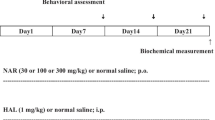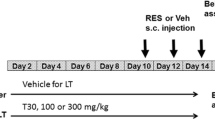Abstract
Haloperidol is a classical neuroleptic drug that is still in use and can lead to abnormal motor activity such as tardive dyskinesia (TD) following repeated administration. TD has no effective therapy yet. There is involvement of calcium in triggering the oxidative damage and excitotoxicity, both of which play central role in haloperidol-induced orofacial dyskinesia and associated alterations. The present study was carried out to investigate the protective effect of calcium channel blockers [verapamil (10 and 20 mg/kg), diltiazem (10 and 20 mg/kg), nifedipine (10 and 20 mg/kg) and nimodipine (10 and 20 mg/kg)] against haloperidol induced orofacial dyskinesia and associated behavioural, biochemical and neurochemical alterations in rats. Chronic administration of haloperidol (1 mg/kg i.p., 21 days) resulted in a significant increase in orofacial dyskinetic movements and significant decrease in % retention, coupled with the marked increase in lipid peroxidation and superoxide anion generation where as significant decrease in non protein thiols and endogenous antioxidant enzyme (SOD and catalase) levels in rat brain striatum homogenates. All these deleterious effects of haloperidol were significantly attenuated by co-administration of different calcium channel blockers. Neurochemically, chronic administration of haloperidol resulted in significant decrease in levels of catecholamines (dopamine, serotonin) and their metabolites (HVA and HIAA) but increased turnover of dopamine and serotonin. Co-administration of most effective doses of verapamil, diltiazem, nifedipine and nimodipine significantly attenuated these neurochemical changes. Results of the present study indicate that haloperidol-induced calcium ion influx is involved in the pathogenesis of tardive dyskinesia and calcium channel blockers should be tested in clinical trials with nifedipine as the most promising one.





Similar content being viewed by others
References
Kim HS, Yumkham S, Choi JH, Kim EK, Kim YS, Ryu SH, Suh PG (2006) Haloperidol induces calcium ion influx via L-type calcium channels in hippocampal HN33 cells and renders the neurons more susceptible to oxidative stress. Mol Cells 22(1):51–57
Kane J (1995) Tardive dyskinesia: epidemiological and clinical presentation. In: Bloom FE, Kupfer DJ (eds) Psychopharmacology: the fourth generation of progress. Raven, New York, pp 1485–1495
Gerlach J, Reys T, Kristjansen P (1978) Effect of baclofen on tardive dyskinesia. Psychopharmacology 56:145–151
Naidu PS, Singh A, Kulkarni SK (2003) Quercetin, a bioflavonoid attenuated haloperidol induced orofacial dyskinesia. Neuropharmacology 44:1100–1106
Naidu PS, Singh A, Kulkarni SK (2002) Carvedilol attenuates neuroleptic-induced orofacial dyskinesia: possible antioxidant mechanisms. Br J Pharmacol 136(2):193–200
Burger ME, Fachineto R, Alves A, Callegari L, Rocha JB (2005) Acute reserpine and subchronic haloperidol treatments change synaptosomal brain glutamate uptake and elicit orofacial dyskinesia in rats. Brain Res 1031(2):202–210
Tsai G, Goff DC, Chang RW, Flood J, Baer L, Coyle JT (1998) Markers of glutamatergic neurotransmission and oxidative stress associated with tardive dyskinesia. Am J Psychiatry 155(9):1207–1213
Torreano PJ, Cohan CS (2003) Calcium and voltage dependent inactivation of sodium and calcium currents limits calcium influx in Helisoma neurons. J Neurobiol 54(3):439–456
Arundine M, Tymianski M (2003) Molecular mechanisms of calcium-dependent neurodegeneration in excitotoxicity. Cell Calcium 34(4–5):325–337. Review
Thayer SA, Usachev YM, Pottorf WJ (2002) Modulating Ca2+ clearance from neurons. Front Biosci 7:d1255–d1279
Sattler R, Tymianski M (2001) Molecular mechanisms of glutamate receptor-mediated excitotoxic neuronal cell death. Mol Neurobiol 24(1–3):107–129. Review
Soares-Weiser K, Rathbone J (2004) Calcium channel blockers for neuroleptic-induced tardive dyskinesia. Cochrane Database Syst Rev (1):CD000206. Review
Pereira JS, Bertolucci PH, Ferraz HB, De Andrade LA (1992) A study on the action of two calcium channel blockers (verapamil and flunarizine) upon an experimental model of tardive dyskinesia in rats. Arq Neuropsiquiatr 50(3):263–268
Cates M, Lusk K, Wells BG (1993) Are calcium-channel blockers effective in the treatment of tardive dyskinesia? Ann Pharmacother 27(2):191–196
Suddath RL, Straw GM, Freed WJ, Bigelow LB, Kirch DG, Wyatt RJ (1991) A clinical trial of nifedipine in schizophrenia and tardive dyskinesia. Pharmacol Biochem Behav 39(3):743–745
Reddy DS, Kulkarni SK (1998) Possible role of nitric oxide in the nootropic and antiamnesic effects of neurosteroids on aging and dizocilpine induced learning impairment. Brain Res 799:215–219
Wills ED (1966) Mechanism of lipid peroxide formation in animal tissues. Biochem J 99:667–676
Ellman GL (1959) Tissue sulfhydryl groups. Arch Biochem Biophys 82:70–77
Babior BM, Kipner RS, Cerutte JT (1973) Biological defense mechanism. The production by leukocytes of superoxide, a potential bacterial agent. J Clin Invest 52:7451–7744
Kono Y (1978) Generation of superoxide radical during auto-oxidation of hydroxylamine and an assay of superoxide dismutase. Arch Biochem Biophys 186:189–195
Luck H (1963) Catalase spectrophotometric method. Methods in enzymatic analysis. Academic press, Newyork
Lowry OH, Rosenbrought NJ, Farr AL, Randall RJ (1951) Protein measurements with the Folin-phenol reagent. J Biol Chem 193:265–275
Church WH (2005) Column chromatography analysis of brain tissue: an advanced laboratory exercise for neuroscience majors. J Undergrad Neurosci Educ 3(2):A36–A41
Hydman J, Remahl S, Bjorck G, Svensson M, Mattsson P (2007) Nimodipine improves reinnervation and neuromuscular function after injury to the recurrent laryngeal nerve in the rat. Ann Otol Rhinol Laryngol 116(8):623–630
Himeda T, Kanbara S, Oki C, Kato H, Araki T (2005) Effects of chronic administration with nilvadipine against immunohistochemical changes related to aging in the mouse hippocampus. Metab Brain Dis 20(2):141–153
Ouardouz M, Zamponi GW, Barr W, Kiedrowski L, Stys PK (2005) Protection of ischemic rat spinal cord white matter: dual action of KB-R7943 on Na+/Ca2+ exchange and L-typeCa2+ channels. Neuropharmacology 48(4):566–575
Carlsson M, Carlsson A (1990) Interaction between glutamatergic and monoaminergic systems within the basal ganglia—implications for schizophrenia and Parkinson’s disease. Trends Neurosci 13:272–276
Bardgett ME, Wrona CT, Newcomer JW, Csernansky JG (1993) Subcortical excitatory amino acid levels after acute and subchronic administration of typical and atypical neuroleptics. Eur J Pharmacol 230:245–250
Perry TL, Hansen S, Kish SJ (1979) Effects of chronic administration of antipsychotic drugs on GABA and other amino acids in the mesolimbic area of rat brain. Life Sci 24:283–288
Olney JW (1990) Excitotoxic amino acids and neuropsychiatric disorders. Annu Rev Pharmacol Toxicol 30:47–71
Cullen PJ, Lockyer PJ (2002) Integration of calcium and ras signaling. Nat Rev Mol Cell Biol 3:339–348
Sagara Y (1998) Induction of reactive oxygen species in neurons by haloperidol. J Neurochem 71:1002–1012
Volterra A, Trotti D, Tromba C, Floridi S, Racagni G (1994) Glutamate uptake inhibition by oxygen free radicals in rat cortical astrocytes. J Neurosci 14:2924–2932
Burkhardt C, Kelly JP, Lim YH, Filley CM, Parker WD (1993) Neuroleptic medications inhibit complex II of the electron transport chain. Ann Neurol 33: 512–517
Jackson-Lewis V, Przedborski S (1994) Neuroleptic medications inhibit complex I of the electron transport chain. Ann Neurol 35:244–245
Simonian NA, Coyle JT (1996) Oxidative stress in neurodegenerative diseases. Annu Rev Pharmacol Toxicol 36:83–106
Anderson JE, Wible CG, McCarley RW, Jakab M, Kasai K et al (2002) An MRI study of temporal lobe abnormalities and negative symptoms in chronic schizophrenia. Schizophr Res 58:123–134
Burger MBE, Fachineto R, Callegari L, Paixao MW, Braga AL, Rocha JBT (2004) Effect of age on reserpine induced orofacial dyskinesia possible protection of diphenyl diselenide. Brain Res Bull 64:339–345
Schwartz PJ, Reaume A, Scott R, Coyle JT (1998) Effects of over- and under-expression of Cu, Zn-superoxide dismutase on toxicity of glutamate analogs in transgenic mouse striatum. Brain Res 789:32–39
Mukherjee S, Mahadik SP, Correnti EE, Scheffer R (1994) The antioxidant defense system at the onset of psychosis. Biol Psychiatry 35:701–708
Andreassen OA, Ferrante RJ, Aamo TO, Beal MF, Jorgensen HA (2003) Oral dyskinesias and histopathological alterations in substantia nigra after long-term haloperidol treatment of old rats. Neuroscience 122(3):717–725
Umemoto S, Tanaka M, Kawahara S, Kubo M, Umeji K, Hashimoto R, Matsuzaki M (2004) Calcium antagonist reduces oxidative stress by upregulating Cu/Zn superoxide dismutase in stroke-prone spontaneously hypertensive rats. Hypertens Res 27(11):877–885
Kouoh F, Gressier B, Dine T, Luyckx M, Brunet C, Ballester L, Cazin JC (2002) Antioxidant effects and anti-elastase activity of the calcium antagonist nicardipine on activated human and rabbit neutrophils—a potential anti-atherosclerotic property of calcium antagonists? Cardiovasc Drugs Ther 16(6):515–520
Lashgari R, Motamedi F, Zahedi Asl S, Shahidi S, Komaki A (2006) Behavioral and electrophysiological studies of chronic oral administration of L-type calcium channel blocker verapamil on learning and memory in rats. Behav Brain Res 171(2):324–328
Shivakumar BR, Ravindranath V (1993) Oxidative stress and thiol modification induced by chronic administration of haloperidol. J Pharmacol Exp Ther 3:1137–1141
Bishnoi M, Chopra K, Kulkarni SK (2006) Involvement of adenosinergic receptor system in an animal model of tardive dyskinesia and associated behavioural, biochemical and neurochemical changes. Eur J Pharmacol 552(1–3):55–66
Bishnoi M, Kumar A, Chopra K, Kulkarni SK (2007a) Comparative neurochemical changes associated with chronic administration of typical and atypical neuroleptics: implications in tardive dyskinesia. Indian J Exp Biol 45(2):175–179
Bishnoi M, Chopra K, Kulkarni SK (2007b) Possible anti-oxidant and neuroprotective mechanisms of zolpidem in attenuating typical anti-psychotic-induced orofacial dyskinesia—a biochemical and neurochemical study. Prog Neuropsychopharmacol Biol Psychiatry 31(5):1130–1138
Acknowledgements
The study was supported by the UGC, New Delhi, grants under Centre with Potential for Excellence in Biomedical Sciences (CPEBS). Mahendra Bishnoi is a Project Associate.
Author information
Authors and Affiliations
Corresponding author
Rights and permissions
About this article
Cite this article
Bishnoi, M., Chopra, K. & Kulkarni, S.K. Protective Effect of L-type Calcium Channel Blockers Against Haloperidol-induced Orofacial Dyskinesia: A Behavioural, Biochemical and Neurochemical Study. Neurochem Res 33, 1869–1880 (2008). https://doi.org/10.1007/s11064-008-9660-6
Received:
Accepted:
Published:
Issue Date:
DOI: https://doi.org/10.1007/s11064-008-9660-6




